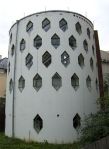Manifesto
What makes a good designer? Is it what they design, or is it how they design it? Every designers mind works in a different way; each one will see creativity in different places and be inspired by different things, noticing the little details around them that speak to them. Some go to art galleries and exhibits for inspiration. Seeing someone else’s designs has always given me perspective on my own, and while I don’t usually go to galleries, I often take out a few minutes of my time to ask my peers for their opinions and to look at some of their work. Seeing how they are doing and how they approach the same brief with a completely different concept to my own enables me to reflect on how well my work is expressing the brief. I hope to keep this perspective throughout my design career, and remember every now and then to simply take a step back from my work and ask a friend for another point of view so that I may see my designs in a different light. Looking at other sources of creative inspiration helps me to keep my work contemporary and original. Having contemporary designs is vital to having a successful career in design, clients aren’t looking for designs that appeal to audiences in the 90’s, what worked last year may not work this year. To ensure big clients, your ideas also need to be original, no one wants something that’s been done a thousand times before. People are always looking for the next big thing, with original, contemporary designs I hope to be a contender, but there are so many original ideas out there that make the industry so colorful.
Diversity is what makes the design industry so interesting for me, with everyone trying to make a name for themselves and develop their own identities. A designers identity is one of his most important assets, you must always remember who you are and what style you are currently using, if you forget your identity, what makes you so unique, then it will show in your designs and you will become uninteresting and generic. I aim to stay true to my identity and to shape and mold it by proving myself a competent and efficient designer to my ever growing and demanding audience. The audience is one of the most import things to consider when designing anything. Exactly whom you are aiming at can inspire or hinder your work depending on your outlook. I aim to seek motivation for my work from the audience, and to never forget precisely who needs whom, for without an audience I wouldn’t have a job. Wherever my life takes me throughout the design industry I hope to hold on to my principles, there are many jobs out there and choosing which one to take isn’t easy; “Should I make a poster for this cigarette company? It’s wrong but the money’s good…” What’s more important? Everyone will think differently thanks to their own principles and unique knowledge about their employer. Personally I will avoid designing for any product that I think is: harmful to the environment, potentially dangerous to humans or animals, using or associated with slavery, cruel to animals, or is discriminatory in any way. What I am prepared to do is work for a company that may have done one or more of these things in the past, as long as they no longer do them or deal with anyone who does.
Knowledge about whom you’re working for is also important; what they like and dislike, what kind of jobs they’ve done in past, what they want this piece to accomplish, the background of the subject matter, knowing these facts will equip you with the mental tools required to come up with an intelligent and original design. This journey we all take through the industry isn’t easy, things will go wrong, (especially with printers) and a designer must be patient. If you’re working within a team then patience becomes even more important, you must respect and listen to all of the other members of the group so that you can work together efficiently. Patience will also help you remember what you like about your work, when things get difficult it may become easy to forget why you started this project, but it is incredibly important to remain passionate about your work. Passion for your work will give you purpose, and it will give your work purpose, for it is purpose that defines us and our work. Graphic design is a maze, a maze with infinite entrances and exits. We all enter the maze in our own way, and come out in different places. What makes a good designer? The journey.
Take it easy
Captain out
P.S. Again those who got the Matrix reference can has cheezburger.



 Posted by captain beefy
Posted by captain beefy 


















